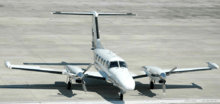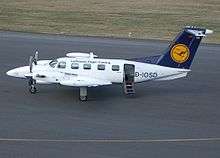Piper PA-42 Cheyenne
The Piper PA-42 Cheyenne is a turboprop aircraft built by Piper Aircraft. The PA-42 Cheyenne is a larger development of the earlier PA-31T Cheyennes I and II (which are, in turn, turboprop developments of the PA-31 Navajo).
| PA-42 Cheyenne | |
|---|---|
_(cropped).jpg) | |
| PA-42-720 Cheyenne IIIA | |
| Role | Turboprop |
| Manufacturer | Piper Aircraft |
| First flight | May 18, 1979 |
| Produced | 1979-1993[1] |
| Number built | 192; 149 IIIAs and 43 400s |
| Unit cost | |
| Developed from | Piper PA-31T Cheyenne |
History
Cheyenne I/II
The Piper Cheyenne prototype first flew in 1969. Designated the PA-31T-620, it was essentially a turboprop evolution of the Piper PA-31 Navajo, powered by two Pratt & Whitney Canada PT6A-28 turboprops rated at 620 hp (460 kW) each. Certification was granted on 3 May 1972. The original Cheyenne, produced from 1974 to 1977, did not carry a Roman numeral suffix designation. Because of difficulties complying with certification standards for longitudinal stability, the Cheyenne and later Cheyenne II are equipped with a Stability Augmentation System (SAS), consisting of a stick-pusher system (actuated by an angle-of-attack sensor) designed to provide the pilot with the appropriate stick force gradient – and to keep the airplane at its trim airspeed when flying near aft center of gravity loadings, high power settings, low airspeeds and high angles of attack. Without the SAS, the aircraft demonstrated neutral static stability in its flight regime. Later in 1978, it was redesignated as the Cheyenne II (PA-31T-2-620), due to the production of the PA-31T-1-500.
In 1978, the Cheyenne I (PA-31T-1-500) was introduced. Powered by two 500 shp (370 kW) Pratt and Whitney PT6A-11 engines, the Cheyenne I was marketed as a low-cost step-up turboprop for Piper loyalists. Due to its reduced power, this airplane does not require an SAS. The Cheyenne IIXL (PA-31T-2-620XL) is a stretched (by two feet) version of the Cheyenne II. Certified in February 1981 and built until 1984, it does not use SAS.
The Cheyenne IA (PA-31T-1A-500), certified May 1983 and produced until 1985, brought together several design improvements to the basic Cheyenne I. A redesigned cowling allowed more air to flow into the engine; situating the propeller closer to the engine air scoop allowed greater recovery of high-velocity ram-air. New, streamlined exhaust stubs yielded more jet thrust than previous models and kept nacelle soot accumulation to a minimum. Together, these changes allowed higher inter-turbine temperature (ITT) limits. Other improvements to the standard airplane airframe included an auto-ignition system, automatic starter disengage for simplified starting procedures and a larger windshield.
Cheyenne III
The PA-42 Cheyenne III was announced in September 1977. The first production Cheyenne III flew for the first time on May 18, 1979 and FAA certification was granted in early 1980. Compared with the Cheyenne II, the PA-42-720 was about 1 m (3 ft) longer, was powered by 537 kW (720-shp) PT6A-41 turboprops and introduced a T-tail, the most obvious external difference between the PA-31T and PA-42, as well as the most significant change to the series. Deliveries of production Cheyenne IIIs began on June 30, 1980.[6] The standard Cheyenne III has a full complement of deicing equipment, Q-tip propellers, more powerful 250-ampere-hour starter-generators and a 6.3 psi pressurization system backed up by an emergency system operated by the right engine's bleed air.
Several key upgrades found available for the Cheyenne IA also became standard for the III. These included the SAS, redesigned exhaust stubs, which, according to Piper, allowed an extra 6 knots (11 km/h) IAS; and a redesigned engine intake air scoop, which allowed for a larger volume of air to enter the engine. In addition, an external air scoop for oil cooling was available instead of using engine intake air.
The PA-42-720 Cheyenne IIIA superseded the Cheyenne III after 88 of the latter aircraft had been delivered with FAA certification in March 1983. The IIIA is similar in appearance to the III but has PT6A-61 engines and 300 ampere starter-generators. The PT6A-61 engine delivers the same 720 horsepower (540 kW) but, with an additional axial compressor, carries that horsepower to a higher altitude. The IIIA also features an improved air conditioning system, speed stacks, increased passenger headroom, and more reliable fuel control units. The IIIA's ordered by Lufthansa feature flight decks configured to resemble that airline's Airbus A310. Alitalia also uses the IIIA for training purposes.
Cheyenne 400
%2C_Luxembourg_PP1238521046.jpg)
In the late 1970s, Piper avoided developing a clean-sheet light business jet to compete with the Cessna Citation I and upgraded its PT6As from 720 to 1,000 hp (540 to 750 kW) Honeywell TPE331-14s. The PA-42-1000 Cheyenne IV was certified in 1984, 44 were built until 1991 and 37 remain in service in 2018. Due to its top speed over 400 mph, it was renamed Cheyenne 400LS when Lear Siegler owned Piper then Cheyenne 400.[7]
Flat rated to ISA+37, the turboprops maintain their power to almost 20,000 ft (6,100 m). The 106 in (2.7 m) Dowty Rotol propellers had four round-tip composite blades and 8 in (20 cm) of ground clearance. Its empennage was enlarged for stability at higher speeds and altitudes, and its fuselage was strengthened. Pressurization was increased to 7.6 psi (0.52 bar) to elevate its ceiling from 35,000 to 41,000 ft (10,700 to 12,500 m) while maintaining a 10,000 ft (3,000 m) cabin.[7]
Its top speed was 351 kn (650 km/h; 404 mph) and it was faster than the Citation I on most trips while burning one-third less fuel. It could cruise at the same long-range speed over 1,842 nmi (3,411 km), 400 nmi (740 km) more. It can carry eight passengers farther than a King Air 200 while cruising 50 kn (93 km/h) faster. It can operate out of 3,000 ft (900 m) runways with a 97 kn (180 km/h) minimum control speed, similar to a King Air 300. It can operate from much shorter hot and high runways than a Citation I and landing is shortened by the rotating speedbrake effect of the propellers in beta pitch.[7]
It can climb directly to FL 410 at its 12,050 lb (5,470 kg) MTOW and typical single-pilot BOWs are 7,850–7,900 lb (3,560–3,580 kg). It can hold 3,819 lb (1,732 kg) of fuel plus two passengers with baggage, while each extra passenger costs 100 nmi (190 km) of range. It has a 98% dispatch reliability and its cabin is quieter than a King Air.[7]
It has 100-hr. inspection intervals, engine midlife inspections are due at 1,500 hr. and overhauls come at 3,000 hr. The fuselage is limited to 15,000 hr while the wing and empennage have 20,000-hr. life limits. Honeywell maintenance plan is $273.71 per hour per engine and $20-25,000 can be needed for schedule tasks and to fix squawks due to poor accessibility. By 2018, early models were sold for $850,000 to $950,000 and late ones for $1-1.2 million.[7]
It was the fastest production turboprop at the time of its introduction.
Variants

- Cheyenne III, model PA-42, equipped with Pratt & Whitney Canada PT6-41 engines
- Cheyenne IIIA, model PA-42-720, equipped with PT6A-61 engines.[8]
- Cheyenne IV, model PA-42-1000, later the Cheyenne 400LS, and then Cheyenne 400. This is the largest aircraft ever made by Piper, with 43 built. Powered by 1,000 shp (750 kW) Garrett TPE-331 engines, and four-blade props.[1]
- Customs High Endurance Tracker (CHET), special surveillance version of the Cheyenne III, fitted with an AN/APG-66 radar and a ventral FLIR; nine built for the U.S. Customs Service.
Specifications

| Variant | III (PA-42)[2] | IIIA (PA-42-720) | 400 (PA-42-1000) |
|---|---|---|---|
| Crew | 1-2 | ||
| Passengers[1] | 6-9 | ||
| Length | 43ft 5in / 13.2m | ||
| Span | 47ft 8in / 14.5m | ||
| Height | 14ft 9in / 4.5m | 17ft 0in / 5.18m [1] | |
| Wing area | 293sq ft / 27.2m²[1] | ||
| Cabin W × H | 4.25 by 4.33 in (108 by 110 mm) | ||
| MTOW | 11,080lb / 5,026kg | 11,200 lb (5,080 kg) | 12,050 lb (5,466 kg) |
| OEW | 6,389lb / 2,898kg | 6,837 lb (3,101 kg) | 7,565 lb (3,431 kg) |
| Fuel Capacity[8] | 562 US gal (2,130 l) 3,752 lb (1,702 kg) |
582 US gal (2,200 l) 3,819 lb (1,732 kg) | |
| 2× Turboprops | P&WC PT6A-41 | P&WC PT6A-61 | Garrett TPE331-14 |
| Unit power | 720 hp (537 kW) | 1,000 hp (746 kW) | |
| Cruise | 290 kn (537 km/h) | LR 282–305 kn (522–565 km/h) Max | LR 298–351 kn (552–650 km/h) Max |
| Range | 1,330 nmi / 2,463 km | 2,270 nmi (4,204 km) | 2,240 nmi (4,148 km) |
| BFL | 3,920 ft (1,195 m) | 3,363 ft (1,025 m) | 3,180 ft (969 m) |
| Ceiling[8] | 33,000 ft (10,100 m) | 35,000 ft (10,700 m) | 41,000 ft (12,500 m) |
| Climb rate[1] | 2,380 ft/min / 12.1 m/s[10] | 2,235 ft/min (11.35 m/s) | 3,242 ft/min (16.47 m/s) |
| Wing loading | 37.8 lb/sq ft (185 kg/m2) | 38.2 lb/sq ft (187 kg/m2) | 41.1 lb/sq ft (201 kg/m2) |
| power/mass | 0.13 hp/lb (0.21 kW/kg) | 0.13 hp/lb (0.21 kW/kg) | 0.17 hp/lb (0.28 kW/kg) |
Operators
The aircraft is operated by private individuals, companies and executive charter operators. A number of companies also use the aircraft as part of fractional ownership programs.
See Also
Related development
Aircraft of comparable role, configuration and era
- Beech Super King Air
- Cessna 441 Conquest II
- Embraer EMB 121 Xingu
- Mitsubishi MU-2
- Piaggio P.180 Avanti
References
- Gerard Frawley. "Piper PA-42 Cheyenne III/400". The International Directory of Civil Aircraft – via Airliners.net.
- "Business jet and turboprop directory". Flight International. 14 Nov 1981.
- "Piper will direct-sell Cheyenne". Flight International. 17 October 1987.
- "Corporate aircraft directory". Flight International. 2 October 1991. p. 41.
- "Corporate Aircraft Buyer's Guide". Flight International. 8 September 1993.
- Robert A Searles (April 2014). "Cheyenne III/IIIA The first of the big Cheyennes". AOPA Pilot: T-2.
- Fred George (Aug 23, 2018). "Piper Cheyenne 400LS: Big Dog Turboprop Could Best A Citation I". Business & Commercial Aviation.
- "Piper PA-42 Type Certificate data sheet No. A23SO" (PDF). FAA. June 24, 2010.
- "Corporate aircraft directory". Flight International. 15 Nov 1989. p. 54.
- Taylor, John W.R. (1988). Jane's All The World's Aircraft 1988-89. Coulsdon, UK: Jane's Defence Data. pp. 455–456. ISBN 0-7106-0867-5.
External links
| Wikimedia Commons has media related to: |

